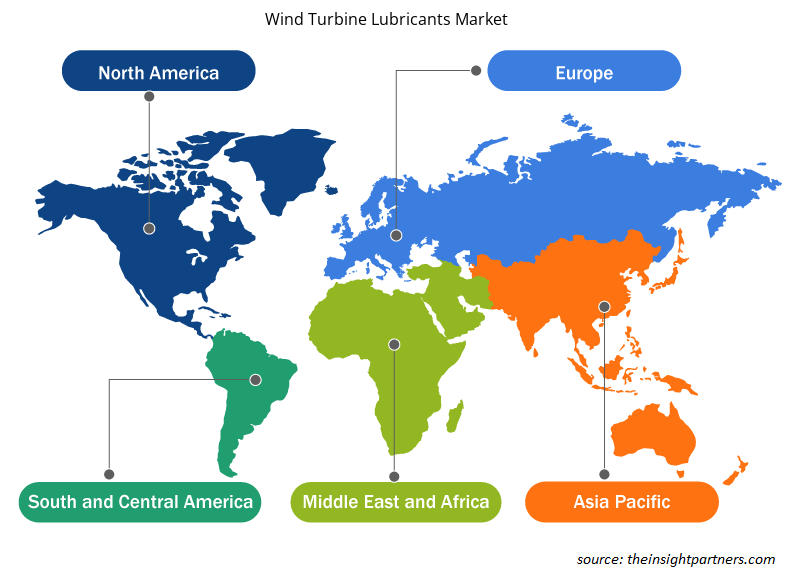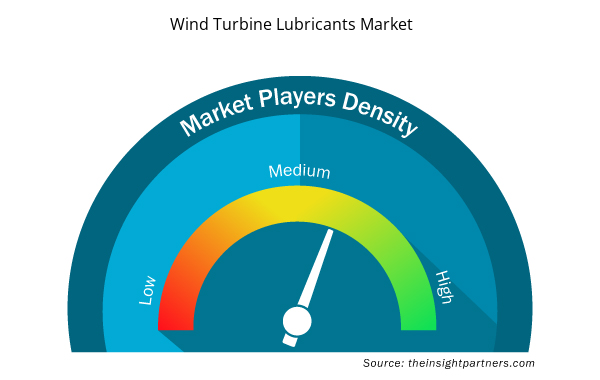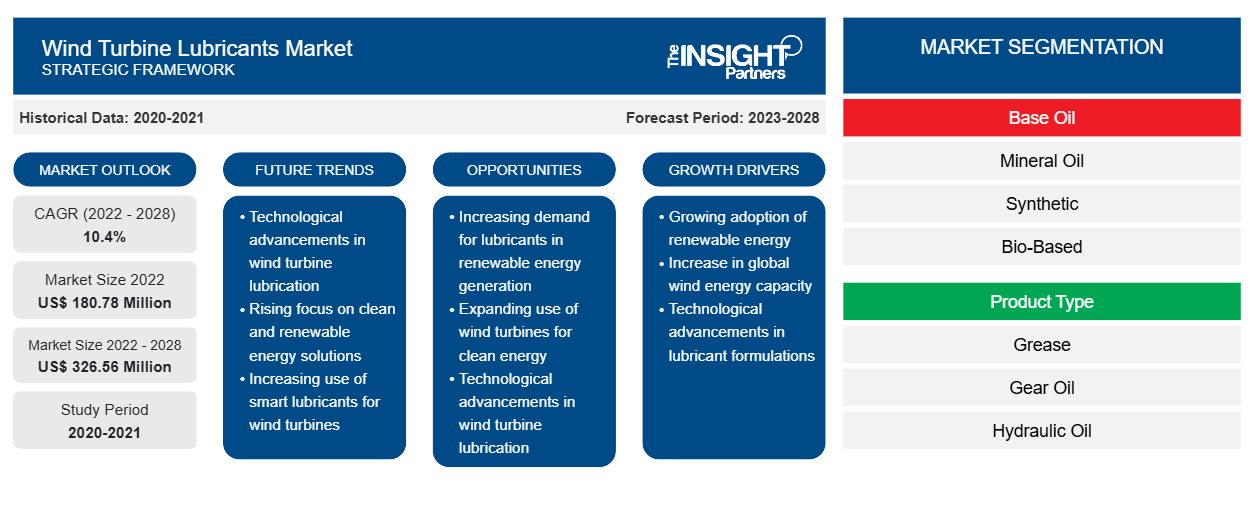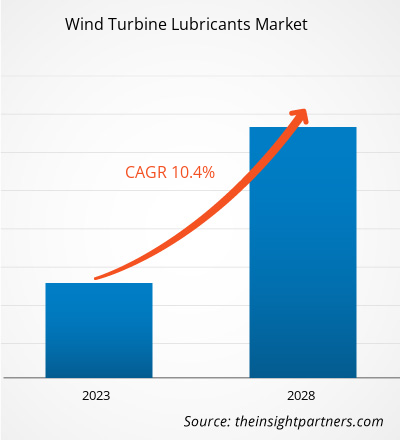[調査レポート] 風力タービン潤滑油 市場規模は、2022年の1億8,078万米ドルから2028年には3億2,656万米ドルに成長すると予想されており、2022年から2028年にかけて10.4%のCAGRを記録すると予測されています。
風力タービンの潤滑油は、風力発電所の機器の運用、保守、信頼性において重要な役割を果たします。風力タービンには、ギアボックス、オープンギア、ピッチギア、ピッチベアリング、ヨーベアリング、油圧システム、発電機ベアリングなど、さまざまな潤滑ポイントがあります。風力タービンで使用されるさまざまな潤滑油には、ギアオイル、油圧オイル、グリースがあります。ギアオイルはギアボックスの潤滑に使用されます。風力タービンでは、メインローターシャフトベアリング、ヨーベアリング、ピッチドライブギア、ブレードベアリング、発電機ベアリングにグリースが使用されます。
2022年、アジア太平洋地域の世界の 風力タービン潤滑油市場シェアは最大でした。アジア太平洋地域の風力タービン潤滑油市場は、オーストラリア、中国、インド、日本、韓国、その他のアジア太平洋地域に分かれています。中国はこの地域の市場成長に大きく貢献しています。同国は10年以上にわたり、世界最大かつ最も急速に成長している再生可能エネルギーの生産国です。さらに、世界最大の風力エネルギー市場でもあります。中国は、固定価格買い取り制度(FiT)の打ち切りにより、2020年も陸上新規追加で世界最大の市場であり続けました。インドでも、国や州政府が採用したさまざまな有利な政策や規制により、風力発電産業が目覚ましい成長を遂げました。さらに、台湾、韓国、ベトナム、フィリピンなどの国々も、風力発電の設置容量を増やすためにさまざまな取り組みを行っており、この地域の風力タービン潤滑油の需要を高めています。
要件に合わせてレポートをカスタマイズする
このレポートの一部、国レベルの分析、Excelデータパックなど、あらゆるレポートを無料でカスタマイズできます。また、スタートアップや大学向けのお得なオファーや割引もご利用いただけます。
- このレポートの主要な市場動向を入手してください。この無料サンプルには、市場動向から見積もりや予測に至るまでのデータ分析が含まれます。
COVID-19パンデミックが風力タービン潤滑油市場に与える影響
再生可能エネルギーに対する政府の支援と風力タービンの設置の増加は、風力タービン潤滑油市場の成長に大きく貢献してきました。しかし、2020年には、国境や国境の制限によって引き起こされたバリューチェーンの混乱により、さまざまな業界が事業を減速せざるを得ませんでした。これにより生産施設が閉鎖され、2020年初頭の風力タービン潤滑油市場の成長に悪影響を及ぼしました。2020年初頭の風力発電設備の減少は、風力タービン潤滑油の需要を妨げました。
しかし、成熟した風力市場と新興の風力市場がパンデミックの影響を克服し始めたため、風力エネルギー部門は今年後半に力強く回復しました。さらに、各国政府が社会的制限の緩和を発表したことで、世界市場はパンデミックの初期に被った損失から回復し始めました。さらに、ワクチン接種率の上昇は、産業の発展に好ましい環境をもたらしました。世界風力エネルギー協議会によると、世界の風力産業は2020年に前年比53%の記録的な成長を遂げました。この産業は、世界的なサプライチェーンとプロジェクト建設の混乱にもかかわらず、COVID-19パンデミックのピーク時に93GWを超える風力発電を設置しました。風力発電の設置容量の急増により、風力タービンのさまざまな部品の潤滑に使用される潤滑油の需要が増加しました。
市場分析
風力発電設備容量の増加により風力タービン潤滑油の需要が増加
風力エネルギーは化石燃料への依存を減らすのに役立ち、さまざまな国でこの再生可能資源への関心が高まっています。世界風力エネルギー協議会が発行した「世界風力レポート2021」によると、2020年には新しい風力発電設備が90GWを超え、2019年に追加された容量より53%高くなりました。これにより、世界全体の設置容量は743GWとなり、2019年と比較して14%増加しました。 2020年には、陸上風力発電所の新しい設備が86.9GWに達し、洋上風力発電所は6.1GWに達し、2020年は陸上風力発電所と洋上風力発電所の新しい設備がそれぞれ史上最高と2番目に多い年となりました。風力タービンのさまざまな部品は、グリース、ギアオイル、油圧オイル、その他の潤滑剤を使用して潤滑する必要があります。したがって、世界的に風力発電の設置容量が増加していることが、風力タービン潤滑油市場の成長を促進しています。
ベースオイルの洞察
ベースオイルに基づいて、世界の風力タービン潤滑油市場は、鉱油、合成、バイオベースに分類されます。合成セグメントは、2022年に最大の風力タービン潤滑油市場シェアを占めました。合成潤滑油は、いくつかの明確に定義された化合物の反応を通じて合成的に製造されたオイル成分でできており、既存の原油や植物油から精製されるのではなく、石油ベースであることがよくあります。合成潤滑油は流動点が低いため、ギアボックスを低温で効率的に動作させることができるため、風力タービン業界で最も一般的に使用されている潤滑油です。
世界の風力タービン潤滑油市場で活動している主要企業には、TotalEnergies、Exxon Mobil Corporation、FUCHS、BP plc、Klüber Lubrication、Shell、Phillips 66 Company、Chevron、Afton Chemical、AMSOIL INC.、The Lubrizol Corporation などがあります。世界の市場の企業は、顧客の需要を満たすために高品質の製品を提供することに重点を置いています。このため、研究開発活動に多額の投資を行っています。
レポートの注目点
- 風力タービン潤滑油市場における進歩的な業界動向は、プレーヤーが効果的な長期戦略を策定するのに役立ちます。
- 先進国市場と発展途上国市場で採用されているビジネス成長戦略
- 2020年から2028年までの風力タービン潤滑油市場の定量分析
- 風力タービン潤滑油の世界需要の推定
- 業界で活動するバイヤーとサプライヤーの有効性を示すポーターの5つの力の分析
- 競争市場の状況を理解するための最近の動向
- 風力タービン潤滑油市場の成長を牽引・抑制する要因と市場動向および見通し
- 商業的利益の基盤となる市場戦略を強調し、市場の成長につながる意思決定プロセスを支援する
- 風力タービン潤滑油の市場規模
- 市場の詳細な概要とセグメンテーション、および風力タービン潤滑油業界の動向
- 有望な成長機会があるさまざまな地域の風力タービン潤滑油市場規模
風力タービン潤滑油市場の地域別分析
予測期間を通じて風力タービン潤滑油市場に影響を与える地域的な傾向と要因は、Insight Partners のアナリストによって徹底的に説明されています。このセクションでは、北米、ヨーロッパ、アジア太平洋、中東、アフリカ、南米、中米にわたる風力タービン潤滑油市場のセグメントと地理についても説明します。

- 風力タービン潤滑油市場の地域別データを入手
風力タービン潤滑油市場レポートの範囲
| レポート属性 | 詳細 |
|---|---|
| 2022年の市場規模 | 1億8,078万米ドル |
| 2028年までの市場規模 | 3億2,656万米ドル |
| 世界のCAGR(2022年 - 2028年) | 10.4% |
| 履歴データ | 2020-2021 |
| 予測期間 | 2023-2028 |
| 対象セグメント | ベースオイル別
|
| 対象地域と国 | 北米
|
| 市場リーダーと主要企業プロフィール |
|
風力タービン潤滑油市場のプレーヤー密度:ビジネスダイナミクスへの影響を理解する
風力タービン潤滑油市場は、消費者の嗜好の変化、技術の進歩、製品の利点に対する認識の高まりなどの要因により、エンドユーザーの需要が高まり、急速に成長しています。需要が高まるにつれて、企業は提供を拡大し、消費者のニーズを満たすために革新し、新たなトレンドを活用し、市場の成長をさらに促進しています。
市場プレーヤー密度とは、特定の市場または業界内で活動している企業または会社の分布を指します。これは、特定の市場スペースに、その規模または総市場価値と比較して、どれだけの競合相手 (市場プレーヤー) が存在するかを示します。
風力タービン潤滑油市場で事業を展開している主要企業は次のとおりです。
- トータルエナジーズ SE
- BP社
- シェブロン
- エクソンモービル株式会社
- フックス・ペトロルブSE
免責事項:上記の企業は、特定の順序でランク付けされていません。

- 風力タービン潤滑油市場のトップキープレーヤーの概要を入手
風力タービン潤滑油市場
風力タービン潤滑油市場は、ベースオイルに基づいて、鉱油、合成、バイオベースに分類されます。世界の風力タービン潤滑油市場は、製品タイプに基づいて、グリース、ギアオイル、油圧オイル、その他に分類されます。
企業プロフィール
- トータルエナジーズ SE
- BP社
- シェブロン
- エクソンモービル株式会社
- フックス・ペトロルブSE
- クリューバー潤滑剤有限会社
- フィリップス66社
- シェル
- ルーブリゾールコーポレーション
- アフトンケミカル
- アムソイル株式会社
- 過去2年間の分析、基準年、CAGRによる予測(7年間)
- PEST分析とSWOT分析
- 市場規模価値/数量 - 世界、地域、国
- 業界と競争環境
- Excel データセット



Report Coverage
Revenue forecast, Company Analysis, Industry landscape, Growth factors, and Trends

Segment Covered
This text is related
to segments covered.

Regional Scope
North America, Europe, Asia Pacific, Middle East & Africa, South & Central America

Country Scope
This text is related
to country scope.
よくある質問
Asia Pacific is estimated to register the fastest CAGR in the global wind turbine lubricants market over the forecast period. The increasing installed wind capacity in China, Japan, India, and Australia, among others, are driving the demand for wind turbine lubricants in Asia Pacific.
The gear oil segment held the largest share of the global wind turbine lubricants market in 2022. Gear oil is one of the most widely used wind turbine lubricants. It is used in lubricating gearboxes. Enclosed gearboxes are an important component in the nacelles of many wind turbines.
The projected growth of the market is attributed to the increasing installed wind capacity and government initiatives for the development of the wind energy sector.
The key players operating in the global wind turbine lubricants market include TotalEnergies, Exxon Mobil Corporation, FUCHS, BP p.l.c., Klüber Lubrication, Shell, Phillips 66 Company, Chevron, Afton Chemical, AMSOIL INC., and The Lubrizol Corporation.
In 2022, Asia Pacific held the largest share of the global wind turbine lubricants market. China is a major contributor to the market growth in Asia Pacific. The country has the world’s largest wind energy market. China remained the world’s largest market for new onshore additions in 2020, driven by the feed-in tariff cut-off. India also records the remarkable growth of the wind power industry due to policies and regulations adopted by the union and state governments.
The synthetic segment held the largest share in the global wind turbine lubricants market in 2022. Synthetic lubricants are made of oil components that have been manufactured synthetically by reaction of a few well-defined chemical compounds. They are the most commonly used lubricants in the wind turbine industry as synthetic oils have a lower pour point, which enables the gearbox to operate efficiently at lower temperature.
Trends and growth analysis reports related to Chemicals and Materials : READ MORE..
The List of Companies - Wind Turbine Lubricants Market
- TotalEnergies SE
- BP p.l.c.
- Chevron
- Exxon Mobil Corporation
- FUCHS Petrolub SE
- Klüber Lubrication GmbH & Co.
- Phillips 66 Company
- Shell Plc
- The Lubrizol Corporation
- Afton Chemical
- AMSOIL INC.
The Insight Partners performs research in 4 major stages: Data Collection & Secondary Research, Primary Research, Data Analysis and Data Triangulation & Final Review.
- Data Collection and Secondary Research:
As a market research and consulting firm operating from a decade, we have published and advised several client across the globe. First step for any study will start with an assessment of currently available data and insights from existing reports. Further, historical and current market information is collected from Investor Presentations, Annual Reports, SEC Filings, etc., and other information related to company’s performance and market positioning are gathered from Paid Databases (Factiva, Hoovers, and Reuters) and various other publications available in public domain.
Several associations trade associates, technical forums, institutes, societies and organization are accessed to gain technical as well as market related insights through their publications such as research papers, blogs and press releases related to the studies are referred to get cues about the market. Further, white papers, journals, magazines, and other news articles published in last 3 years are scrutinized and analyzed to understand the current market trends.
- Primary Research:
The primarily interview analysis comprise of data obtained from industry participants interview and answers to survey questions gathered by in-house primary team.
For primary research, interviews are conducted with industry experts/CEOs/Marketing Managers/VPs/Subject Matter Experts from both demand and supply side to get a 360-degree view of the market. The primary team conducts several interviews based on the complexity of the markets to understand the various market trends and dynamics which makes research more credible and precise.
A typical research interview fulfils the following functions:
- Provides first-hand information on the market size, market trends, growth trends, competitive landscape, and outlook
- Validates and strengthens in-house secondary research findings
- Develops the analysis team’s expertise and market understanding
Primary research involves email interactions and telephone interviews for each market, category, segment, and sub-segment across geographies. The participants who typically take part in such a process include, but are not limited to:
- Industry participants: VPs, business development managers, market intelligence managers and national sales managers
- Outside experts: Valuation experts, research analysts and key opinion leaders specializing in the electronics and semiconductor industry.
Below is the breakup of our primary respondents by company, designation, and region:

Once we receive the confirmation from primary research sources or primary respondents, we finalize the base year market estimation and forecast the data as per the macroeconomic and microeconomic factors assessed during data collection.
- Data Analysis:
Once data is validated through both secondary as well as primary respondents, we finalize the market estimations by hypothesis formulation and factor analysis at regional and country level.
- Macro-Economic Factor Analysis:
We analyse macroeconomic indicators such the gross domestic product (GDP), increase in the demand for goods and services across industries, technological advancement, regional economic growth, governmental policies, the influence of COVID-19, PEST analysis, and other aspects. This analysis aids in setting benchmarks for various nations/regions and approximating market splits. Additionally, the general trend of the aforementioned components aid in determining the market's development possibilities.
- Country Level Data:
Various factors that are especially aligned to the country are taken into account to determine the market size for a certain area and country, including the presence of vendors, such as headquarters and offices, the country's GDP, demand patterns, and industry growth. To comprehend the market dynamics for the nation, a number of growth variables, inhibitors, application areas, and current market trends are researched. The aforementioned elements aid in determining the country's overall market's growth potential.
- Company Profile:
The “Table of Contents” is formulated by listing and analyzing more than 25 - 30 companies operating in the market ecosystem across geographies. However, we profile only 10 companies as a standard practice in our syndicate reports. These 10 companies comprise leading, emerging, and regional players. Nonetheless, our analysis is not restricted to the 10 listed companies, we also analyze other companies present in the market to develop a holistic view and understand the prevailing trends. The “Company Profiles” section in the report covers key facts, business description, products & services, financial information, SWOT analysis, and key developments. The financial information presented is extracted from the annual reports and official documents of the publicly listed companies. Upon collecting the information for the sections of respective companies, we verify them via various primary sources and then compile the data in respective company profiles. The company level information helps us in deriving the base number as well as in forecasting the market size.
- Developing Base Number:
Aggregation of sales statistics (2020-2022) and macro-economic factor, and other secondary and primary research insights are utilized to arrive at base number and related market shares for 2022. The data gaps are identified in this step and relevant market data is analyzed, collected from paid primary interviews or databases. On finalizing the base year market size, forecasts are developed on the basis of macro-economic, industry and market growth factors and company level analysis.
- Data Triangulation and Final Review:
The market findings and base year market size calculations are validated from supply as well as demand side. Demand side validations are based on macro-economic factor analysis and benchmarks for respective regions and countries. In case of supply side validations, revenues of major companies are estimated (in case not available) based on industry benchmark, approximate number of employees, product portfolio, and primary interviews revenues are gathered. Further revenue from target product/service segment is assessed to avoid overshooting of market statistics. In case of heavy deviations between supply and demand side values, all thes steps are repeated to achieve synchronization.
We follow an iterative model, wherein we share our research findings with Subject Matter Experts (SME’s) and Key Opinion Leaders (KOLs) until consensus view of the market is not formulated – this model negates any drastic deviation in the opinions of experts. Only validated and universally acceptable research findings are quoted in our reports.
We have important check points that we use to validate our research findings – which we call – data triangulation, where we validate the information, we generate from secondary sources with primary interviews and then we re-validate with our internal data bases and Subject matter experts. This comprehensive model enables us to deliver high quality, reliable data in shortest possible time.


 このレポートの無料サンプルを入手する
このレポートの無料サンプルを入手する